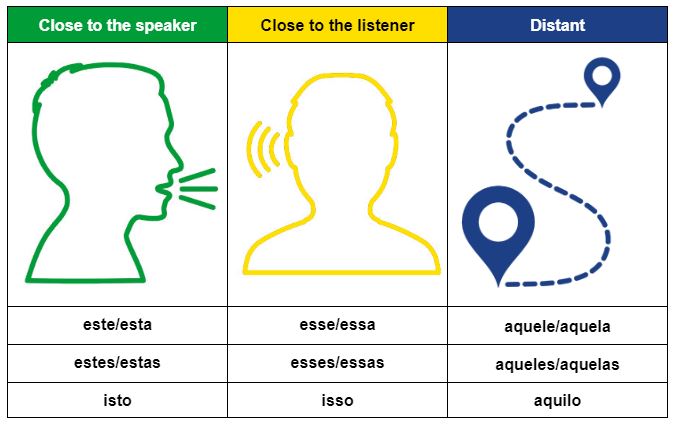This page outlines use of demonstratives in Brazilian Portuguese. Demonstratives are words used to point to, or to draw attention to people or things.
In Brazilian Portuguese, demonstratives must agree in gender (masculine, feminine or neutral), number (singular or plural) and in relative distance to the thing that is being pointed to.
Importance of distance from the speaker and listener
Distance can refer to things that are close to the speaker, things that are close to the listener. or things that are distant from both the speaker and the listener. In English, the words ‘this’ and ‘these’ refer to things that are close to the speaker, while ‘that’ and ‘those’ refer to things that are close to the listener or distant from both the speaker and the listener.
In Brazilian Portuguese, there is one word for ‘this’ and two words for ‘that’. A distinction is made between the ‘that’ that is close to the listener and the ‘that’ that is distant from both the speaker and the listener.

Masculine and feminine demonstratives
The table below lists demonstratives used to point to nouns in Brazilian Portuguese. As most nouns in Brazilian Portuguese are either masculine or feminine, the demonstrative must agree in gender with the thing being pointed to:
| SINGULAR | masculine | feminine | e.g. |
| This (close to the speaker) | este 🔊 | esta 🔊 | este prato (this plate) |
| That (close to the listener) | esse 🔊 | essa 🔊 | esse livro (that book) |
| That (distant) | aquele 🔊 | aquela 🔊 | aquele homem (that man) |
These demonstratives also have plural forms:
| PLURAL | masculine | feminine | e.g. |
| These (close to the speaker) | estes | estas | estes pratos (these plates) |
| Those (close to the listener) | esses | essas | esses livros (those books) |
| Those (distant) | aqueles | aquelas | aqueles homens (those men) |
Gender neutral demonstratives
When no specific noun is being referred to or when the name of something is unknown, Brazilians use gender neutral demonstratives.
Note that gender neutral demonstratives in Brazilian Portuguese are always singular.
The table below lists the gender neutral demonstratives, which must agree in distance to the thing being pointed to:
| This (close to the speaker) | isto | o que é isto? (what’s this) |
| That (close to the listener) | isso | isso é fantástico (that’s fantastic) |
| That (distant) | aquilo | o que é aquilo? (what ‘s that?) |
Contractions of demonstratives in Brazilian Portuguese
We’ve seen on a previous page about contractions in Brazilian Portuguese, which are shortened words created when two words are combined. Prepositions can be combined with demonstratives to create contractions.
The table below shows contractions of the preposition em with the appropriate demonstrative to create ‘in this’/‘on this’, or ‘in that/‘on that’’:
| Close to the speaker (in this/on this) | Close to the listener (in that/on that) | Distant (in that/on that) |
| em + este = neste | em + esse = nesse | em + aquele = naquele |
| em + esta = nesta | em + essa = nessa | em + aquela = naquela |
| em + estes = nestes | em + esses = nesses | em + aqueles = naqueles |
| em + estas = nestas | em + essas = nessas | em + aquelas = naquelas |
E.g. o que tem naquela garagem? = what’s in that garage?
The table below shows contractions of the preposition de with the appropriate demonstrative to create ‘from this’/‘of this’, or ‘from that’/‘of that’:
| Close to the speaker (from this/of this) | Close to the listener (from that/of that) | Distant (from that/of that) |
| de + este = deste | de + esse = desse | de + aquele = daquele |
| de + esta = desta | de + essa = dessa | de + aquela = daquela |
| de + estes = destes | de + esses = desses | de + aqueles = daqueles |
| de + estas = destas | de + essas = dessas | de + aquelas = daquelas |
E.g. é daquela casa = it is from that house
Contractions of gender neutral demonstratives
The gender neutral demonstratives isto, isso and aquilo can also be contracted in the following ways:
| em | de | |
| isto | em + isto = nisto | de+ isto = disto |
| isso | em + isso = nisso | de + isso = disso |
| aquilo | em + aquilo = naquilo | de + aquilo = daquilo |
E.g. what is on this? = o que há nisso?
| 👈 Previous page | Next page 👉 |
| Weather types and seasons | Adverbs |
